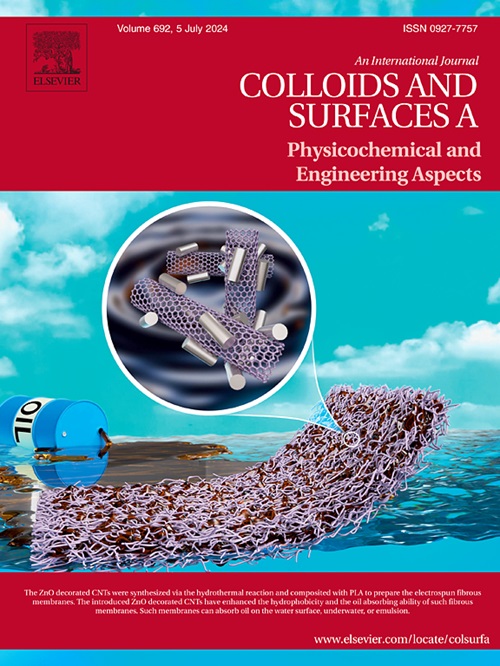Pressurized carbon dioxide-assisted hydrophobic modification of silica aerogel to reduce thermal conductivity
IF 5.4
2区 化学
Q2 CHEMISTRY, PHYSICAL
Colloids and Surfaces A: Physicochemical and Engineering Aspects
Pub Date : 2025-07-16
DOI:10.1016/j.colsurfa.2025.137755
引用次数: 0
Abstract
This study proposed a method employing pressurized carbon dioxide (CO2) to improve the hydrophobicity of silica aerogel. The effects of aging time, reaction temperature, and reaction time on the extent of hydrophobic modification were investigated systematically using scanning electron microscopy, water contact angle measurements, Fourier transform infrared analyses, thermogravimetric analyses, and thermal conductivity measurements. The results indicated that the use of CO2 pressurization significantly promoted the hydrolysis of hexamethyldisilazane (HMDS) and participated in the hydrophobic modification of the aerogel, enhancing the substitution of Si-OH on the aerogel surface with Si-CH₃ to provide excellent thermal stability. Under the optimal reaction conditions, the water contact angle, specific surface area, and average pore diameter of the silica aerogel reached 150.76°, 645.95 m²/g, and 18.07 nm, respectively. Furthermore, an electrostatic potential analysis confirmed that (CH₃)₃Si-OH generated by the pressurized CO2-promoted hydrolysis of HMDS exhibited highly nucleophilic and electrophilic sites, making it more susceptible to substitution reactions with ![]() Si-OH. Critically, the use of CO2 pressurization helped to discharge the water inside the silica aerogel, thereby reducing the capillary force and drying stress while improving the skeletal structure to obtain an aerogel with excellent hydrophobic properties and a spatial structure that considerably reduced its thermal conductivity. Therefore, this study demonstrated a new approach for the preparation of hydrophobic silica aerogels with low thermal conductivity.
Si-OH. Critically, the use of CO2 pressurization helped to discharge the water inside the silica aerogel, thereby reducing the capillary force and drying stress while improving the skeletal structure to obtain an aerogel with excellent hydrophobic properties and a spatial structure that considerably reduced its thermal conductivity. Therefore, this study demonstrated a new approach for the preparation of hydrophobic silica aerogels with low thermal conductivity.
加压二氧化碳辅助二氧化硅气凝胶疏水改性以降低导热性
本研究提出了一种采用加压二氧化碳(CO2)改善二氧化硅气凝胶疏水性的方法。采用扫描电子显微镜、水接触角测量、傅里叶变换红外分析、热重分析和导热系数测量等方法,系统地研究了老化时间、反应温度和反应时间对疏水改性程度的影响。结果表明,CO2加压显著促进了六甲基二矽氮烷(HMDS)的水解,参与了气凝胶的疏水修饰,增强了Si-OH在气凝胶表面被Si-CH₃取代,提供了优异的热稳定性。在最佳反应条件下,二氧化硅气凝胶的水接触角、比表面积和平均孔径分别达到150.76°、645.95 m²/g和18.07 nm。此外,静电电位分析证实,加压co2促进HMDS水解生成的(CH₃)₃Si-OH具有高度的亲核和亲电位点,使其更容易与Si-OH发生取代反应。至关重要的是,使用CO2加压有助于排出二氧化硅气凝胶内部的水,从而减少毛细力和干燥应力,同时改善骨架结构,从而获得具有优异疏水性和空间结构的气凝胶,大大降低了其导热性。因此,本研究为制备低导热疏水二氧化硅气凝胶提供了一条新的途径。
本文章由计算机程序翻译,如有差异,请以英文原文为准。
求助全文
约1分钟内获得全文
求助全文
来源期刊
CiteScore
8.70
自引率
9.60%
发文量
2421
审稿时长
56 days
期刊介绍:
Colloids and Surfaces A: Physicochemical and Engineering Aspects is an international journal devoted to the science underlying applications of colloids and interfacial phenomena.
The journal aims at publishing high quality research papers featuring new materials or new insights into the role of colloid and interface science in (for example) food, energy, minerals processing, pharmaceuticals or the environment.

 求助内容:
求助内容: 应助结果提醒方式:
应助结果提醒方式:


